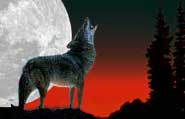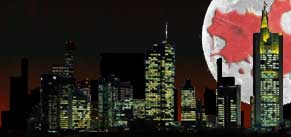


| |
|
by William D. Gagliani (Originally published in BookLovers magazine) Elaine Bergstrom wrote advertising copy until she realized she could be writing fiction. So, she did. Her first attempt resulted in Shattered Glass (1989), and
brought both critical acclaim and flattering comparisons to Anne
Rice, the acknowledged queen of contemporary gothic vampire novels. There is no doubt Elaine Bergstrom has arrived. "I've always been drawn to vampires," she confides with
a grin. "Don't ask why! Probably, I'm a masochist at heart.
Also, a good Catholic upbringing. I'm uptight, so I want to be swept
off my feet by someone who's going to use me terribly. So I'm a
masochistic Victorian!" Bergstrom's novels are filled with lush sensuality, whether they
take place in the present or in a well-developed period past. "You write what you were interested in when you were younger,"
she explains. "In my case it was partly horror and an awful
lot of gothic, which probably explains my writing style now."
Though consciously heading more and more into mainstream, she acknowledges
the connection. "Someone told me they thought Shattered
Glass [her first novel] was gothic -- heroine in jeopardy, strange
place and era ... it has a lot of that feel." What leads one to write of horrific events, always seeking to show
the dark side of human nature and the consequences of evil? "I read a lot of people very early that normally you wouldn't
read when you were younger. Robert Bloch, certainly. Dostoyevsky
-- I was a real fan of his psychological horror. In the fantasy
realm, I can remember reading everything by Andre Norton when I
was a kid. And there are some little-known mainstream authors: I
love Marilyn Harris' work; J.R. Salamanca, who wrote Lilith, on
which the Jean Seberg movie was based. I'll read anything by Anne
Rice, even if it's bad Anne Rice." This reference to Anne Rice is ironic, given the frequent comparisons
made between the two writers' works. Such comparison can have unexpected
results, which Bergstrom is quick to point out. "It didn't
bother me so much for the first book," she says. Blurbs by such popular writers can help sell the work of newcomers.
Bergstrom continues: "It has bothered me a little bit that
they tend to want to use that quote over and over again on the covers.
I would hate to think that people aren't reading my work because
they think I'm like Anne Rice and they didn't like her. We are quite
different. I think I am more strongly plotted than she is; she's
more literary than I am." Nevertheless, a meeting with Anne Rice at the upcoming World Fantasy
Convention would be welcome, and Bergstrom hopes it will come about. Like most novelists, Elaine Bergstrom began early on to exhibit
the qualities of a good horror writer. "I started doing fiction
when I was 9 or 10 years old. I had an old Royal typewriter and
one summer I started pounding out a Bobbsey Twins Meet Jack the
Ripper sort of thing." Although she wrote some poetry in college, she dedicated herself
to other kinds of writing and dropped out of fiction altogether.
She graduated from Marquette University with a journalism degree,
but her future writing experiences would vary. "I did article writing, news writing, and a lot of ad writing.
I worked as a private investigator for a while -- which was good
experience for what I do now -- and then I went back to ad writing.
Copy writing in retail ... trained monkeys can do it, so I had a
lot of time on my hands. People kept paperbacks at their desks and
I thought, 'I'll just write one!' So I put paper in the machine
and started up. I never went back to work full time again." Of course, even first novels are never as simple as that first
courageous step, and Bergstrom had to make decisions that would
affect her writing career -- even if she didn't know it. "I was originally going to do my novel as a period piece --
1800s, somewhere like Europe, with a guy in a castle. That sort
of ended up being in my work, but a bit later in the story. Then
I started deciding, what if the vampire was just trying to pass
like you and me, and what would he deal with? And then I thought,
if he's doing that, I might as well set it in a place I know real
well, so I decided I'd set it in Cleveland, because I grew up there."
She realized that the relatively liberal early 80s would have robbed
her novel of the romantic interplay she sought. The character she
had created was so charismatic that if he approached the average
woman she would have melted, giving in to his advances without hesitation.
Bergstrom also felt uncomfortable dealing with modern-day forensics,
so it made more sense to set it in the past. "I read a lot
of dated forensics books." "There's a phenomenal amount of research that goes into anything,"
she explains. "I postulated that the family was from Portugal."
But she couldn't travel there to experience the setting firsthand,
as some writers do. "Paperback writers don't have that kind
of money!" Bergstrom improvised, covering the bases thoroughly.
"I grabbed travel guides, accounts of people who had travelled
to Portugal, a Fodor's to check the weather." And the results?
"I feel really pleased because I have had anthology people
come to me and say, 'Do something in a European setting, because
you do it so well.' And I've never been there." No serious writer ever wastes research done but not immediately
used. "For Blood Rites I did a lot of research into
the minds of serial killers, which was handy when I did Daughter
of the Night and I was able to recycle what I'd learned." While plotting Shattered Glass, Bergstrom found it necessary
to plot the events that became Blood Alone. And so a series
was born. In fact, a third novel was written to follow Blood
Alone that has yet to be published. "It's a post-holocaust
novel -- very science fictionish -- but unfortunately no one seems
to want to publish it, so it's sitting in limbo. Berkley did not
want to publish a science fiction horror novel from me, because
they didn't feel I was well-known enough that the book wouldn't
wind up in a different slot altogether from my previous stuff, thereby
bringing numbers down. And this is a numbers game. I don't disagree
with them or that exactly, except I do want that book to come out.
It may come out in small press, someday, or maybe I'll talk someone
into taking it, because I really like it!" Horror novelists must struggle to present the dark side of our
psyche, especially in these days of political correctness and increased
sensitivity. Yet, fear is perhaps the most basic emotion and --
in that sense -- pure. From the dawn of time, people have told scary
stories to overcome their natural fears. How to scare her readers without resorting to spewing blood and
bone-crunching action? Bergstrom seems to handle the dichotomy well.
"I don't like 'cutting edge' horror, by and large, graphic
horror, or things that go for the gross-out. I think there is an
eroticism to my work that does not lend itself to such treatment.
I guess I'm tired of novels that have blood in them -- you know,
where the title is Blood This and Blood That."
In her own work, she has only been asked once to tone down a scene
-- for TSR. "I took exception to toning it down very much,
so I didn't tone it down very much, and I suspect it was just fine
the way it had been originally written. I don't know quite what
it was that they didn't like about it, but they do have standards
and writers are expected to adhere to them. I understand, because
you're writing for a younger market. I usually don't cross those
boundaries anyway. Blood Rites was more trouble for me to
write because I don't particularly like to get too gory, and that's
probably the goriest book I've written." Her newest novel is Mina, the Dracula sequel that bears
a new author's name -- Marie Kiraly. Bergstrom chose her late grandmother's
name as a tribute, and hopes that it will do well on its own, while
helping to separate the chronicles of the Austras from her more
mainstream work. "Mina is much softer than some of my previous books.
It's more a possession story than a vampire novel, though there
is a great deal of blood drinking in it. It's a book about the liberation
of the libido, forbidden fantasies, vampire romance, and Victorian
stuffiness -- a grand mix!" The novel is decidedly non-violent, considering its subject matter
(see following review). "I guess there's only so much you can
do before you have to start moving into something that's a little
softer, a little less bloody, and a little less monster oriented." Bergstrom shows real concern about violence in society, but is
careful to point out that in recent violent movies such as "Boys'n
th'Hood" and "New Jack City," "the violence
is shown to be a nihilism that just leads nowhere, so they're more
like morality plays. Or "The Crow." Man, it's a violent
movie, but it's a morality play where good triumphs over evil, or
at least evil is shown to be pointless." She believes movies
are moving away from violence, and would like to see "less
gross and more adult horror movies. I think that "Wolf"
is more of an adult movie. I would like to see horror go back to
adults, the way it used to be." Since she is currently working
on a screen adaptation of her own work, it's likely she will attempt
to bring these beliefs to a new medium. Bergstrom does not shy away from sexuality, on the other hand.
"It's like doing an exercise in killing somebody with a pen,"
she points out. "You have to learn how to kill on paper if
you want to be a horror writer. You also have to know how to write
a good sex scene -- I'm a very sensual writer, I've been told, and
I do strive for that intentionally." Her next book, tentatively entitled The Rose Wallpaper (published
as Leanna), she describes as "a ghost story with voodoo
undertones set in New Orleans." It will be even softer than
Mina, likely showcasing Bergstrom's talent for sensual, atmospheric
writing. With this much work in such a short period of time, you'd think
Elaine Bergstrom might be taking a well-deserved holiday from writing.
Well, in a way she is. Working with Apex Travel, Bergstrom is hoping to coordinate a week-long
tour of Dracula's London. "We're going to meet someone from
the Vampire Society in London, probably do a club -- if we're lucky,
someone like Nosferatu will be playing -- then tour Highgate Cemetery
and maybe take a trip up to Whitby, and do all the places that Dracula
hung out at. Apparently some of the pubs where Van Helsing met with
Jonathan and Mina are still open and we can go lift a tankard there.
Maybe we'll do a side tour -- Jack the Ripper, because it's in the
same area." It sounds like grand, romantic fun. And who better to share it with than someone who has helped plot the vampire's fate? In the meantime, Bergstrom is not resting. Secure in her own career,
she has now begun to pass on some of her knowledge, leading several
on-going novel workshops for Redbird Studios. It's not her first
brush with teaching: "I've taught journalism at Alverno, and
at the Great Lakes Writers Workshop, right when my first novel was
coming out. I feel I have a lot more to offer now, a lot more knowledge
and expertise. Then, I just had enthusiasm. I still have that." Not the first writer to discover the positive effects of teaching,
Bergstrom confesses: "I get a big kick out of doing this."
She receives useful input from other people, people who are often
struggling with the same writing problems that may plague her own
work. "I feel more creative when I leave this workshop than
I feel all week." The fledgling writers feel that way, too,
so the by-weekly experience becomes a lifeline for those whose greatest
dream is to populate a novel with valiant characters fighting dark,
horrific demons in and outside of their minds. Her body of work is impressive, and growing rapidly. Her enthusiasm
and love of the subject belie the darkness often unjustly attributed
to it. Her sensual style brings scenes and characters to life, often
without the traditional bloodletting. Elaine Bergstrom helps local
writers achieve some measure of what she has achieved, and provides
the best possible example for beginners to follow. Elaine Bergstrom has written five novels of the Austra family of
vampires, including the brand new Nocturne. She is working
on a sequel. She has also written about Edgar Allan Poe (Madeline)
and Aleister Crowley (The Door Through Washington Square),
as well as a sequel to Dracula (Mina).
|